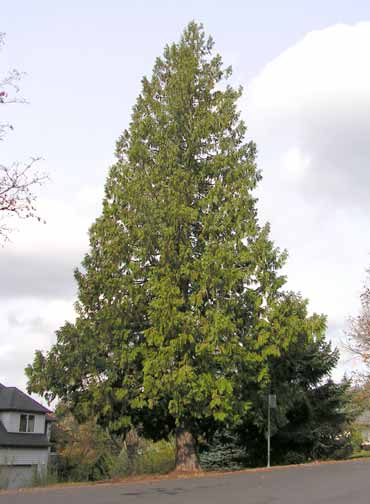The Nature of Cedar Mill
Western redcedar
By Kyle Spinks, Natural Resources TechnicianTualatin Hills Park and
Recreation District
Western redcedar (Thuja plicata – pronounced ‘THOO-yuh pli-KAH-tuh)
is probably the tree best known to Northwesterners. Native Americans
from Alaska to northern California, and as far inland as the Rocky
Mountains, prized this tree for its myriad uses. Canoes, clothing,
shelter, nets, and tools were made from all parts of the tree, from roots
to shoots, heartwood to bark. Medical and spiritual uses were common as well,
and included such things as drinking teas to relieve pain and waving smoking
limbs to ward off evil household spirits.
 As with the Native Americans throughout
the ages, redcedar is highly prized by today’s builders because of
its beauty and its resistance to decay. This decay resistance is
because redcedar, like the redwood and sequoia species to the south, accumulates ‘extractives’ (metabolic
byproducts) in its wood. These byproducts are toxic (or at least
not tasty) to many bugs and pathogens. Many years, even decades,
after a redcedar has fallen in the forest, its wood perseveres on
the forest floor, long after other trees have decayed back into the soils. As with the Native Americans throughout
the ages, redcedar is highly prized by today’s builders because of
its beauty and its resistance to decay. This decay resistance is
because redcedar, like the redwood and sequoia species to the south, accumulates ‘extractives’ (metabolic
byproducts) in its wood. These byproducts are toxic (or at least
not tasty) to many bugs and pathogens. Many years, even decades,
after a redcedar has fallen in the forest, its wood perseveres on
the forest floor, long after other trees have decayed back into the soils.
Western
redcedar is a shade-loving species, and is well adapted to cool,
maritime regions or moist valleys. The soft, shredding, reddish bark
and tapering bases with large buttressing flutes easily distinguish this
tree from other trees. Many may grow to 130 feet tall and over 3 feet in
diameter on average, though much larger specimens are common in our western
forests (the largest known Western redcedar, along the shore of Lake Quinault
on the Olympic Peninsula, is 173 feet tall and 19 feet in diameter). Under
the right conditions these trees can live to over 450 years, producing copious
seed each year after the age of about 20. Another of redcedar’s attributes
is its proficiency at sprouting on downed logs (nurse logs), forming
linear stands of new growth on the backs of fallen giants of yesteryear.
The
name ‘redcedar’ is compound, indicating that it isn’t
a member of the family of true cedars (which are native to the Eurasian
continent). The compound or hyphenated common names of some of our
other natives also indicate misnomers: Douglas-fir (not a true fir),
poison-oak (not part of the oak family), and Oregon-grape (not a grape).
But you only need to live here a short time to understand that no matter
what you call it, western redcedar is the icon of Northwest nativeness.
|
